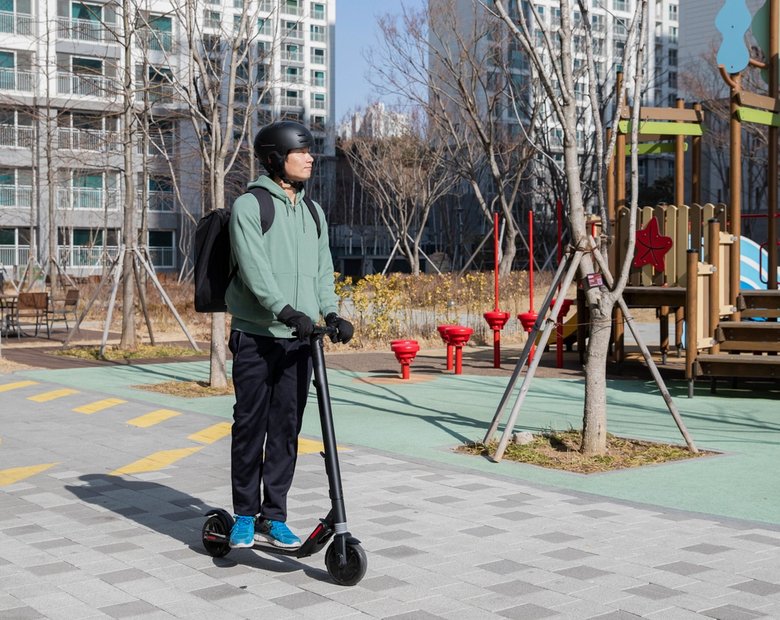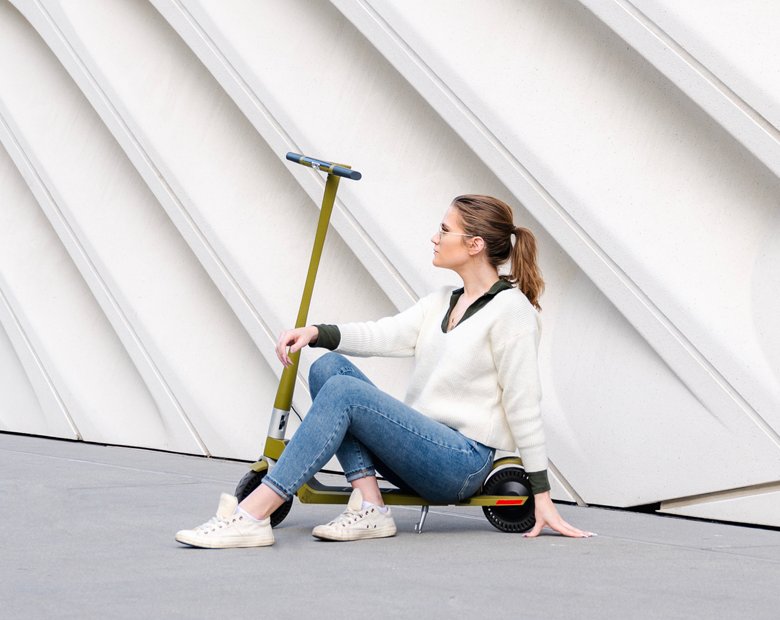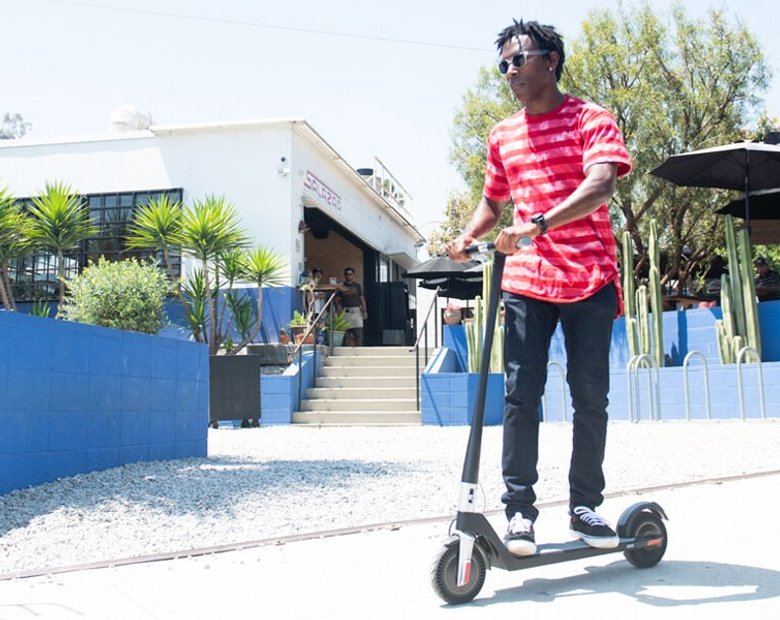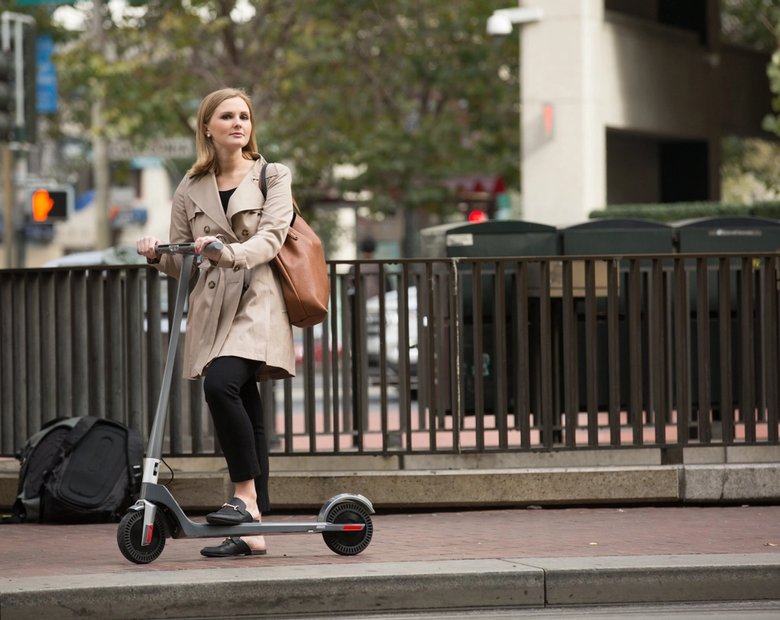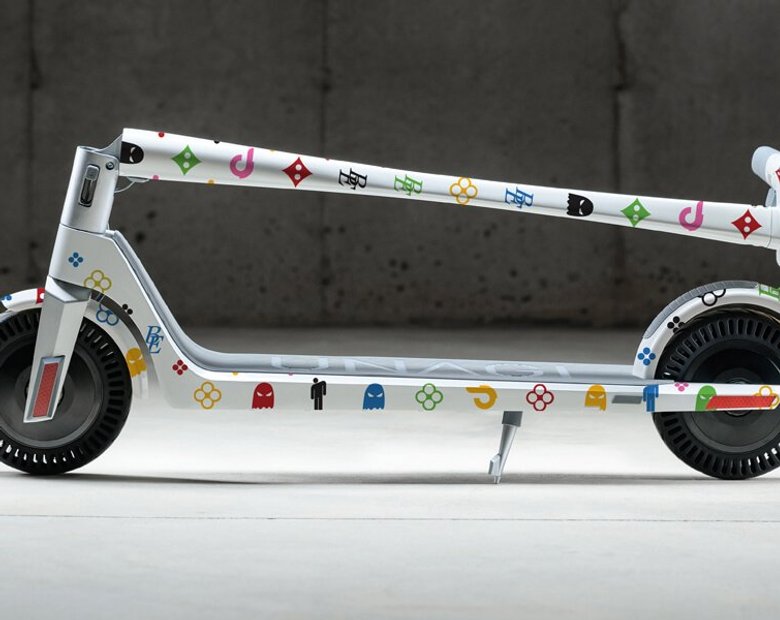If you want to keep riding for longer, the manufacturer's recommendation is - you shouldn't ride your e scooter like a kick scooter!
There are very real reasons why you may need to ride your electric scooter manually.
In this article, we'll tell you what makes e scooters unsuited for manual operation. As well as those emergency situations when you may well resort to use your electric scooter manually.
Let's dive in...
Electric scooters are NOT kick scooters
- 38.5 million (2018) to 88.5 million (2019) - the number of people riding an electric scooter in the US jumped by more 100 percent. (Source: National Association of City Transportation Officials (NACTO), 2019)
If you're one of the millions of Americans considering making the daily commute to work and back on an electric scooter - you definitely want to sign up for speed, agility, smoothness and comfort.
Which you won't have with a kick scooter. And the effort needed to constantly manually push to keep your scooter moving. It can simply be too much trouble.
What exactly is a kick scooter?
Firstly, kick scooters should not be confused with electric kick scooters. They're NOT the same.
Electric 'kick' scooters - is just another name for e scooters - 'stand-up' scooters driven by a wheel hub electric motor, and powered by a battery.
A kick scooter - is only ever used manually. It requires you to power the scooter forward with one or two kicks at the start. And continuing to use one foot to kick away from the ground or pavement to keep going.
Great fun for children and teens playing outdoors and going on short trips accompanied by an adult. But not really an ideal option for the daily urban commute.
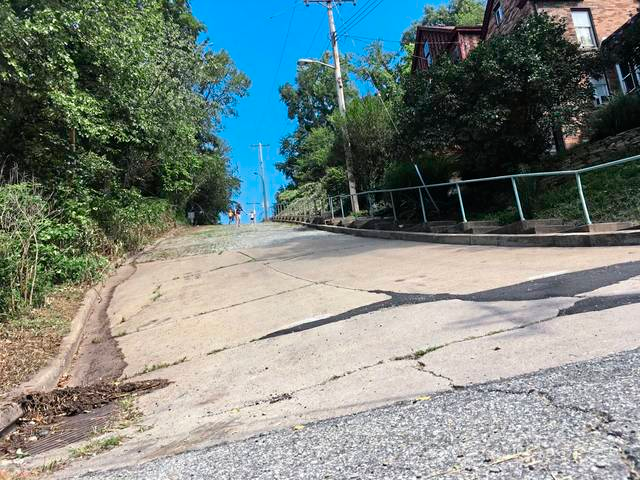
Why it's not easy to ride electric scooters manually
Most models of electric scooter are not designed for manual use. They're not the easiest to push or ride without motor assistance.
So why treat your electric scooter like a kick scooter if you don't have to? Damage can be caused - to you and your e scooter. If your scooter cuts out when you're far from your destination, you should consider using public transport or taking a taxi home.
Most electric scooters are hard to ride manually because of:
Weight and bulk
The average weight of an e scooter is 13 kg (28.6 lbs) but can range up to 22.6 kgs (50 lbs) or more. Heavy and bulky electric scooters tend to have a combination of larger and heavier frames.
- Additional weight may be the result of your electric scooter packing dual hub motors and a larger, heavier battery.
The extra bulk can be a real challenge to be pushed manually over a short distance let alone longer distances.
Lightweight and portable
Some types of electric scooter are designed to be compact and, therefore, highly portable. This means a focus on the key features of lightweight construction and foldability for easy storage. Particularly, the handlebar folding mechanism.
This class of e scooter is purpose-built to be light, and easy to ride for short urban commutes. But it also means they:
- May not provide the necessary comfort, safety and stability for manual riding over long distances - or even any distance at all. You want your daily commute to always be as physically undemanding and smooth as possible.

Rider Weight
A rider's weight has to be considered. In some cases, a heavier rider will simply need to exert more physical effort to keep the scooter moving forward.
Manual riding will, therefore, be more demanding, especially over longer distances. Which can quickly lead to exhaustion, and being unable to continue.
It's strongly advised to catch public transport for continuing the journey, or if a long way from home.
Lower battery capacity
It's sometimes mistakenly thought you can "save battery energy" by riding manually, like a regular scooter.
An electric scooter's 'range' depends on its rechargeable battery. As with most electric vehicles, however, your make and model of electric scooter will have its own battery capacity.
How far your e scooter will travel on a single charge will rely on its battery type and cells. As well as other factors, such as total weight carried, riding style, and ground conditions.
Most scooters will carry lithium-ion batteries produced by major brands such as LG or Samsung. But not always. Some low budget scooters may be powered by a lower capacity battery.
The ability of a battery to store and deliver energy is determined by:
- Watt hours (Wh) - electrical energy equivalent to one watt of power stored and availableto be used over one hour. More watt-hours means more energy stored to produce a longer range.
-and-
- Amp hours (Ah) - how much electrical charge (measured in number of amps) a battery can supply per hour. A higher number of amp-hours means a greater amount of energy stored to provide longer mileage, and a better range.
A smaller battery capacity is generally unsuited for a longer manual ride. If your e scooter runs out of stored energy it will soon need recharging. Double-check your battery capacity first. And you should always ensure its fully charged before starting any ride.
Extreme temperatures
An electric battery tends to perform most efficiently within a specific temperature range.
If you ride your e scooter in during temperature extremes - of either very hot or very cold - you may experience some drastic affects. It could mean reduced battery power and range.
Riding your scooter manually in extreme temperatures is no exception, and could cause a costly electronics malfunction.

Riding surface and effort needed
Different ground surfaces and terrains will directly impact the effort needed to manually push and ride your e scooter.
Loose gravel, for example, creates ground friction, and natural resistance to moving your e scooter forward.
- Riding manually on gravel roads, rough tarmac and green areas demands more physical effort than riding on a flat road, pavement or other more level surfaces.
The increased effort can:
- Quickly drain your energy and even slow you down to a full stop.
Ultimately, you may not be able to safely travel very far at all on any rough and uneven riding surface.
Potential scooter damage
Manually riding on particular ground surfaces can also put your e scooter at risk of potential damage.
- Your scooter tires may churn up the gravel, small stones and other debris.
If they enter the wheel hubs you could potentially have issues with:
- Wheels sticking and seizing up.
- Brake problems, such as grinding noises or failing to respond adequately.
- Damage to other internal components.
Additionally, excessive vibrations, judders and jolts from riding on gravel can:
- Exert additional stress on the scooter's frame, suspension, and other mechanical parts.
Large wheels and tires
Many tires fitted to an electric scooter have a diameter of up to 11 ins. This is considered wide enough to cause sufficient surface friction - and therefore, resistance to movement - without motor assistance.
Small wheels and tires
An e scooter fitted with smaller tires of around 8 ins may also not be well-suited to be used manually.
Especially, over uneven surfaces and rough terrain, such as gravel roads or green areas.
- Smaller wheels can simply struggle to give you the necessary stability and smoothness you need for prolonged manual use.
Lack of suspension
An electric scooter with no suspension - or inadequate suspension - may deliver excessive shudders and vibrations that could throw you off balance when ridden manually. Hardly a pleasant, comfortable experience.
Higher deck
Electric scooters have a higher and wider deck than kick scooters.
- The added distance from the ground may force you to extend your knees more when manual riding.
An unnatural posture is not just awkward. It can also add to:
- Increased strain and discomfort on the one foot you use to constantly keep up the kick action needed.
Shorter handlebars
Similarly, short handlebars may not give you enough grip to keep your electric scooter stable when manually riding, especially on uneven ground or rough terrain.
Loose handlebar
You may feel the handlebar on your electric scooter has worked slightly loose over a period of time. It's not uncommon on some scooters.
Trying to ride your electrical scooter manually when a handlebar is not 100 per cent tight and secure is clearly a huge safety risk. Both to your own safety and the safety of pedestrians, and other commuters.
- A loose handlebar can reduce steering precision, and prevent you from maintaining stable control and stability. You will NOT ride safely.
High-Performance Scooters
Most of the reasons why you should not ride an electric scooter manually definitely apply if you have a high - performance racing scooter. And even more so.
E scooter models specifically designed for high-performance and racing are built for speed. This means the body framework, in particular, is constructed to a high-level aerodynamic, lightweight specification.
To achieve an enhanced performance:
- Speed and maneuverability take priority over stability and comfort.
Your performance electric scooter may simply be too lightweight to withstand the rigours of manual riding.
Reduced Speed and Range
Essentially, using an electric scooter manually will simply not give you the same level of riding efficiency as you would when it's used as intended - as an electric scooter.
- Your speed will naturally slow and your range is also likely to reduce.
- Considerable effort needed when faced with uphill climbs - or any noticeable gradient.
The distance you may be able to cover by manual operation, alone, will depend upon:
- Your physical stamina and the terrain you are trying to ride across.

When can electric scooters be used manually?
It's essential to always follow the manufacture's instructions and advice on your particular make and model of e scooter. Or risk causing costly damage as well as reducing performance, safety and overall lifespan.
However... there can be specific occasions when riding your electric scooter manually is possible - or the only option you have at the time, including:
When it has a manual ride mode
Some electric scooters do offer a manual mode. It's a specific setting - usually accessed via cockpit control - that's designed to keep the sensitive components of electric scooters safe when riding without electric power.
A scooter's manual ride mode is also sometimes referred to as:
- Kick mode
-or-
- Non-electric mode
IMPORTANT: Always check the manufacturer's user manual and official website for specific details and instructions on when and how you can safely use the manual ride mode. Your model may have strict limitations imposed on speed and range.
Battery dies
You should always ensure your battery is fully charged before starting your ride. Or quite simply, the battery dies on you at some point in the journey. Which can be a serious safety risk, especially if there's heavy traffic around.
Forgetting to charge a very low battery could mean you'll have a completely dead battery, and no charge at all.
Flat tire
Tire flats can sometimes happen during you ride, such as mounting or dismounting a curb. You may only discover you have a flat just before you start your journey. Either way, you may have no time to do a proper repair. Or you don't have an emergency puncture repair kit.
Brake failure
A failing brake system, whether mechanical or electronic, is a most serious safety risk. As soon as your scooter brakes become unresponsive, you must stop and consider manual riding or using public transport.
Electronic malfunction
Any electronic malfunction can affect your ability to control your scooter. This is because each system component is directly connected to the correct functioning of your scooter. From the handlebars to the battery, throttle, brakes and wheel hub motor to front and rear lights.
Feeling unwell or had an accident
If you start feeling unwell as you're riding or you've had a minor scrape while maneuvering - you should stop immediately. Before your condition potentially worsens. And consider whether you feel able to safely continue riding manually, use public transport or take a taxi home.
Can electric scooters be used manually with regenerative braking?
Some electric scooters have regenerative brakes*. Which could also be used to help with conserving battery energy.
*Check the accompanying manufacturers manual and their website.
Regenerative brakes enable the conversion of kinetic energy ( energy created by movement) into electrical energy, and recharge the scooter's battery.
How does regenerative braking work?
Energy is 'created' when you brake or decelerate. This energy can be used to convert into electrical energy and recharge the battery cells.
The scooter battery can also receive an amount of charge even when riding in manual mode. Although the amount of charge will be less compared to riding under normal, electric scooter power.
Regenerative brakes can:
- Boost energy efficiency
- Extend range
- Reduce wear on mechanical braking components
IMPORTANT TO NOTE: Regenerative braking is most efficient and effective for energy conversion when riding at higher speeds or heavier deceleration. Performance will very much depend on your particular scooter model, travelling conditions and riding style.

Advantages of riding your scooter manually
There can be some advantages to riding an electric scooter manually. When your battery is not in active use to move your scooter forward.
Saving battery energy
Pushing your scooter forward manually means you're saving energy and NOT using the remaining charge stored in the battery cells. This will be crucial if:
- Your battery capacity is small.
- You forgot to fully charge your battery.
Manual moving saves battery energy when you only have a limited amount of battery life left, and you need to reach your destination using only the remaining charge.
Extended range
You can potentially travel a greater distance on a single charge when riding your scooter manually. Powering off your motor and relying on physical effort will save any stored battery charge, and help extend overall range.
Reduced strain and longer life
Uninterrupted use of the motor places a constant demand upon the battery. Potentially, creating strain, affecting performance, and contributing towards a shortened lifespan.
Much will depend on the capacity and quality of your scooter battery cells.
If you want to help extend the working life of your battery, you could give your battery a "break". But it's always best to use your scooter's 'manual mode', if available.
Summary
Riding your electric scooter manually can be used in an emergency, for example, when your battery dies, brakes fail or your tire gets a flat.
It may be better to ride manually if you face a steep hill climb. Or crossing difficult ground surfaces, such as gravel roads or green areas.
Your particular make and model of scooter may be unsuited to riding manually.
You should always use 'manual mode' on your scooter if it has this setting (Check with the manufacturer).
Riding manually requires effort and physical stamina, which may not be for you.












